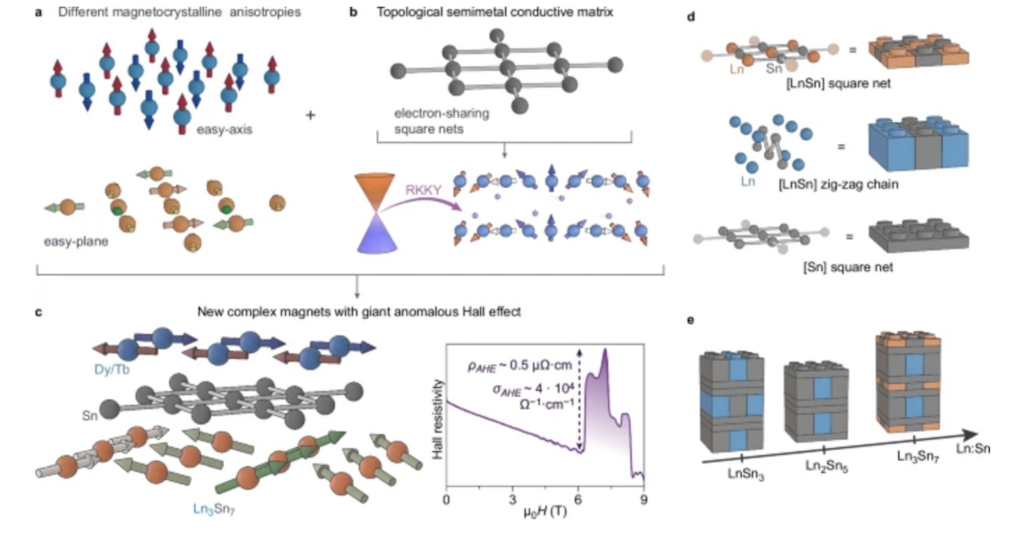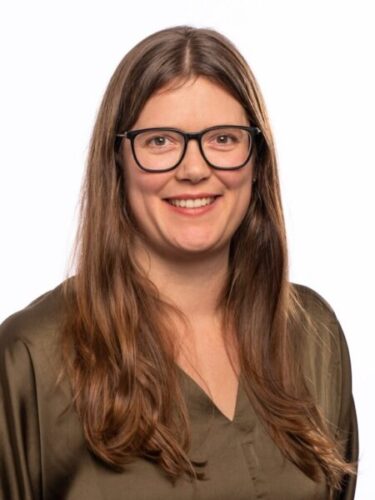Schoop Lab Publishes a Chemical Design Strategy to find Noncoplanar Magnets

Spintronics is emerging as a potential opportunity for more efficient data storage of the future by exploiting the intrinsic spin of the electron and its associated magnetic moment. In a recent paper, the Schoop Lab identifies a design strategy for materials that could one day find application with this technology. Following is a summary of their research.
PAPER: Designing giant Hall response in layered topological semimetals
JOURNAL: Nature Communications.
AUTHORS: Grigorii Skorupskii, Fabio Orlandi, Iñigo Robredo, Milena Jovanovic, Rinsuke Yamada, Fatmagül Katmer, Maia Vergniory, Pascal Manuel, Max Hirschberger, and Leslie Schoop.
CHIEF COLLABORATORS: Department of Applied Physics and Quantum-Phase Electronics Center, University of Tokyo; RIKEN Center for Emergent Matter Science, Japan.
WHAT IT IS: This proof-of-concept paper marks a first step towards the intelligent design of complex magnets for use with next-generation data storage. In it, the Schoop Lab and collaborators report a simple, “real-space” chemical design scheme with layered bulk crystalline intermetallics that identifies noncoplanar magnets. Their process obtains a single-crystal state that hosts a complex array of magnetic phases.
Professor of Chemistry Leslie Schoop describes their recipe as a three-layer “Lego-like” build out that elicits a very clear electrical transport response. It also happens to have one of the highest anomalous Hall conductivities in the noncoplanar magnetic phase.
WHAT THEY DID: The research strategy is based on three key elements: (1) taking a layered magnetic system where the layers are sufficiently decoupled to be considered separately; (2) ensuring the layers contain sublattices with dissimilar magnetic anisotropies in order to produce noncoplanar texture from two coplanar building blocks; and (3) combining them with a topological semimetal conductive framework, which would provide high carrier mobilities and electrons with unconventional energy dispersions, known to result in noncollinear magnetism.
This approach, applied to bulk crystalline intermetallics, allowed researchers to identify the air-stable noncoplanar magnets Dy3Sn7 and Tb3Sn7.
Noncoplanar magnets have magnetic moments that do not share a common plane in their orientations. It is this differential that scientists could one day exploit to create 0 and 1 bits for use with next-generation data storage.
COMMENT FROM P.I. LESLIE SCHOOP: “The crystal structure had been reported but nobody had ever measured properties of it, and I think also no one had grown a single crystal. Someone had solved the crystal structure and put it in a database, but the material was grown in powder form. Grigorii figured out how to grow crystals and then measure the properties, and that is when we saw these giant changes in the resistivity as we had hoped.”

Professor Leslie Schoop.
“There was a big jump in the Hall effect. It’s like an order of magnitude. We are showing one order higher, on par with the highest ever measured. So it’s not only that we showed that this works. We showed that it works really, really well and gives a very large signal.
“People who work in spintronics have been trying to design these things for a long time. That’s basically my favorite thing to do: simplify a complex problem. I hope that we will change how people think about designing the next new materials.”
COMMENT FROM LEAD AUTHOR GRIGORII SKORUPSKII: “As materials chemists, we want to have synthetic control over materials’ properties. However, magnetic orders can often be difficult to predict or produce intentionally – particularly the more complex noncollinear and noncoplanar types that are especially relevant to recently proposed technological solutions. The key success of our study was in us showing how we can use chemical thinking to obtain such orders.”

Schoop Lab Postdoc Grigorii Skorupskii, lead author on the Nature Communications paper.
“If you want to store data in a magnetic material, you need some way of reading out the information. As we want, ultimately, for our data storage device to be used in electronics, this readout would ideally be through some electrical measurement. Noncollinear and noncoplanar orders sometimes have clear signatures of their magnetic order in their electrical transport – resistivity and Hall effect – making them particularly suitable.
“Generally, we are quite far from applications yet. But I think it is safe to say that our study gives us a better understanding of how to make technologically relevant materials in the future. This was my first project as a postdoc and is in a very different field from my doctoral work. Together with Leslie, we developed this project into a large multi-laboratory thrust, and that was a great experience.”
NEXT STEPS: The material orders only at cryogenic temperatures and consequently has no direct application for data storage, so more investigations are needed. The recipe nevertheless serves as an effective model to help researchers obtain similar complex magnetism under more relevant conditions.
FUNDING: This work was supported by the Arnold and Mabel Beckman Foundation; Materials supplies were supported by the Air Force Office for Scientific Research (AFOSR) under grant number FA9550-23-1-0635 (awarded to L.M.S.); the National Science Foundation; the Japan Society for the Promotion of Science (JSPS), and the Princeton Catalysis Initiative.
